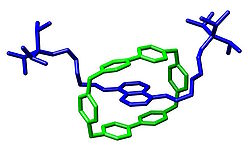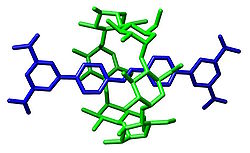
Rotaxane
Encyclopedia

Mechanically-interlocked molecular architectures
Mechanically interlocked molecular architectures are connections of molecules not through traditional bonds, but instead as a consequence of their topology. This connection of molecules is analogous to keys on a key chain loop. The keys are not directly connected to the key chain loop but they...
consisting of a "dumbbell shaped molecule" which is threaded through a "macrocycle
Macrocycle
A macrocycle is, as defined by IUPAC, "a cyclic macromolecule or a macromolecular cyclic portion of a molecule." In the chemical literature, organic chemists may consider any molecule containing a ring of nine or more atoms to be a macrocycle...
" (see graphical representation). The name is derived from the Latin for wheel (rota) and axle (axis). The two components of a rotaxane are kinetically trapped since the ends of the dumbbell (often called stoppers) are larger than the internal diameter of the ring and prevent disassociation (unthreading) of the components since this would require significant distortion of the covalent bonds.
Much of the research concerning rotaxanes and other mechanically-interlocked molecular architectures, such as catenane
Catenane
A catenane is a mechanically-interlocked molecular architecture consisting of two or more interlocked macrocycles. The interlocked rings cannot be separated without breaking the covalent bonds of the macrocycles. Catenane is derived from the Latin catena meaning "chain"...
s, has been focused on their efficient synthesis. However, examples of rotaxane have been found in biological systems including: cystine knot
Cystine knot
A cystine knot is a protein structural motif where two disulfide bridges are formed. The sections of polypeptide that occur between them then form a loop through which a third disulfide bond passes, forming a rotaxane substructure...
peptides, cyclotides or lasso-peptides such as microcin J25 are protein, and a variety of peptides with rotaxane substructure.
Synthesis
The earliest reported synthesis of a rotaxane in 1967 relied on the statistical probability that if two halves of a dumbbell-shaped molecule were reacted in the presence of a macrocycleMacrocycle
A macrocycle is, as defined by IUPAC, "a cyclic macromolecule or a macromolecular cyclic portion of a molecule." In the chemical literature, organic chemists may consider any molecule containing a ring of nine or more atoms to be a macrocycle...
that some small percentage would connect through the ring. To obtain a reasonable quantity of rotaxane, the macrocycle was attached to a solid-phase support
Solid-phase synthesis
In chemistry, solid-phase synthesis is a method in which molecules are bound on a bead and synthesized step-by-step in a reactant solution; compared with normal synthesis in a liquid state, it is easier to remove excess reactant or byproduct from the product. In this method, building blocks are...
and treated with both halves of the dumbbell 70 times and then severed from the support to give a 6% yield. However, the synthesis of rotaxanes has advanced significantly and efficient yields can be obtained by preorganizing the components utilizing hydrogen bond
Hydrogen bond
A hydrogen bond is the attractive interaction of a hydrogen atom with an electronegative atom, such as nitrogen, oxygen or fluorine, that comes from another molecule or chemical group. The hydrogen must be covalently bonded to another electronegative atom to create the bond...
ing, metal coordination, hydrophobic forces
Hydrophobic effect
The hydrophobic effect is the observed tendency of nonpolar substances to aggregate in aqueous solution and exclude water molecules. The name, literally meaning "water-fearing," describes the segregation and apparent repulsion between water and nonpolar substances...
, covalent bond
Covalent bond
A covalent bond is a form of chemical bonding that is characterized by the sharing of pairs of electrons between atoms. The stable balance of attractive and repulsive forces between atoms when they share electrons is known as covalent bonding....
s, or coulombic interactions. The three most common strategies to synthesize rotaxane are "capping", "clipping", and "slipping", though others do exist. Recently, Leigh et al. described a new pathway to mechanically-interlocked architectures involving a transition-metal center that can catalyse a reaction through the cavity of a macrocycle.
Capping

Clipping
The clipping method is similar to the capping reaction except that in this case the dumbbell shaped molecule is complete and is bound to a partial macrocyle. The partial macrocycle then undergoes a ring closing reaction around the dumbbell shaped molecule forming the rotaxane.Slipping
The method of slipping is one which exploits the kinetic stability of the rotaxane. If the end groups of the dumbbell are an appropriate size it will be able to reversibly thread through the macrocycle at higher temperatures. By cooling the dynamic complex it becomes kinetically trapped as a rotaxane at the lower temperature."Active template" methodology
Leigh et al. recently began to explore a strategy in which template ions could also play an active role in promoting the crucial final covalent bond forming reaction that captures the interlocked structure (i.e., the metal has a dual function, acting as a template for entwining the precursors and catalyzing covalent bond formation between thereactants).
Potential applications

Molecular machines
Rotaxane-based molecular machines have been of initial interest for their potential use in molecular electronicsMolecular electronics
Molecular electronics, sometimes called moletronics, involves the study and application of molecular building blocks for the fabrication of electronic components...
as logic molecular switch
Molecular switch
A molecular switch is a molecule that can be reversibly shifted between two or more stable states. The molecules may be shifted between the states in response to changes in e.g. pH, light, temperature, an electrical current, microenvironment, or the presence of a ligand. In some cases, a...
ing elements and as molecular shuttle
Molecular shuttle
A molecular shuttle in supramolecular chemistry is a special type of molecular machine capable of shuttling molecules or ions from one location to another. This field is of relevance to nanotechnology in its quest for nanoscale electronic components and also to biology where many biochemical...
s. These molecular machines are usually based on the movement of macrocycle
Macrocycle
A macrocycle is, as defined by IUPAC, "a cyclic macromolecule or a macromolecular cyclic portion of a molecule." In the chemical literature, organic chemists may consider any molecule containing a ring of nine or more atoms to be a macrocycle...
on the dumbbell. The macrocycle
Macrocycle
A macrocycle is, as defined by IUPAC, "a cyclic macromolecule or a macromolecular cyclic portion of a molecule." In the chemical literature, organic chemists may consider any molecule containing a ring of nine or more atoms to be a macrocycle...
can rotate around the axis of the dumbbell like a wheel and axle or it can slide along its axis from one site to another. Controlling the position of the macrocycle
Macrocycle
A macrocycle is, as defined by IUPAC, "a cyclic macromolecule or a macromolecular cyclic portion of a molecule." In the chemical literature, organic chemists may consider any molecule containing a ring of nine or more atoms to be a macrocycle...
allows the rotaxane to function as molecular switch with each possible location of the macrocycle corresponding to a different state. These rotaxane machines can be manipulated both by chemical and photochemical inputs. Rotaxane based systems have also been demonstrated as molecular muscles. In 2009, there was a report of a "domino effect" from one extremity to the other in a Glycorotaxane Molecular Machine. In this case, the 4C1 or 1C4 chair-like conformation of the mannopyranoside stopper can be controlled, depending on the localization of the macrocycle.
Ultrastable dyes
Potential application as long lasting dyes is based on the enhanced stability of the inner portion of the dumbbell shaped molecule. Studies with cyclodextrinCyclodextrin
Cyclodextrins are a family of compounds made up of sugar molecules bound together in a ring ....
protected rotaxane azo dyes established this characteristic. More reactive squaraine dye
Squaraine dye
Squaraine dyes are a class of organic dyes showing intense fluorescence, typically in the red and near infrared region . They are characterized by their unique aromatic four membered ring system derived from squaric acid...
s have also been shown to have enhanced stability by preventing nucleophilic attack
Nucleophile
A nucleophile is a species that donates an electron-pair to an electrophile to form a chemical bond in a reaction. All molecules or ions with a free pair of electrons can act as nucleophiles. Because nucleophiles donate electrons, they are by definition Lewis bases.Nucleophilic describes the...
of the inner squaraine moiety. The enhanced stabilities of rotaxane dyes is attributed to the insulating effect of the macrocycle
Macrocycle
A macrocycle is, as defined by IUPAC, "a cyclic macromolecule or a macromolecular cyclic portion of a molecule." In the chemical literature, organic chemists may consider any molecule containing a ring of nine or more atoms to be a macrocycle...
which is able to block interactions with other molecules.
Nanorecording
In a nanorecording application a certain rotaxane is deposited as a Langmuir-Blodgett filmLangmuir-Blodgett film
A Langmuir–Blodgett film contains one or more monolayers of an organic material, deposited from the surface of a liquid onto a solid by immersing the solid substrate into the liquid. A monolayer is adsorbed homogeneously with each immersion or emersion step, thus films with very accurate...
on ITO
Indium tin oxide
Indium tin oxide is a solid solution of indium oxide and tin oxide , typically 90% In2O3, 10% SnO2 by weight. It is transparent and colorless in thin layers while in bulk form it is yellowish to grey...
coated glass. When a positive voltage
Voltage
Voltage, otherwise known as electrical potential difference or electric tension is the difference in electric potential between two points — or the difference in electric potential energy per unit charge between two points...
is applied with the tip of a scanning tunneling microscope
Scanning tunneling microscope
A scanning tunneling microscope is an instrument for imaging surfaces at the atomic level. Its development in 1981 earned its inventors, Gerd Binnig and Heinrich Rohrer , the Nobel Prize in Physics in 1986. For an STM, good resolution is considered to be 0.1 nm lateral resolution and...
probe, the rotaxane rings in the tip area switch to a different part of the dumbbell and the resulting new conformation
Conformational isomerism
In chemistry, conformational isomerism is a form of stereoisomerism in which the isomers can be interconverted exclusively by rotations about formally single bonds...
makes the molecules stick out from the surface by 0.3 nanometer and this height difference turns out to be sufficient for a memory dot. It is not yet possible to erase such a nanorecording film.
Nomenclature
Accepted nomenclature is to designate the number of components of the rotaxane in brackets as a prefix. Therefore the graphical representation of rotaxane displayed above would be a [2]rotaxane as it consists of a single dumbbell and a single macrocycle.See also
- CatenaneCatenaneA catenane is a mechanically-interlocked molecular architecture consisting of two or more interlocked macrocycles. The interlocked rings cannot be separated without breaking the covalent bonds of the macrocycles. Catenane is derived from the Latin catena meaning "chain"...
- Mechanically-interlocked molecular architecture
- Molecular Borromean ringsMolecular Borromean ringsMolecular Borromean rings are an example of a mechanically-interlocked molecular architecture in which three macrocycles are interlocked in such a way that breaking any macrocycle allows the others to disassociate. They are the smallest examples of Borromean rings. The synthesis of molecular...
- Molecular knots

